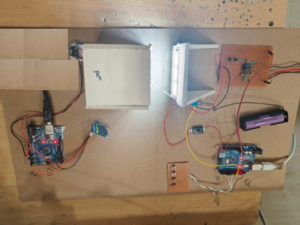No products in the cart.
Arduino UNO & IOT Projects, Electrical Projects (BTech MTech), Electronics Projects (BTech MTech)
IOT Based Hybrid Solar and Wind based Charging Station using Arduino
Availability:
1 in stock
An IoT-based Hybrid Solar and Wind Charging Station is an innovative project designed to generate renewable energy from both solar and wind sources. This system can be used for charging electric vehicles, batteries, or other devices, while providing real-time data monitoring and control via the Internet of Things (IoT). By integrating solar and wind power, the system ensures a reliable energy source even when one resource is not available, making it ideal for sustainable energy solutions.
₹9,500.00 ₹10,500.00
1 in stock
IoT-Based Hybrid Solar and Wind Charging Station Using Arduino
An IoT-based Hybrid Solar and Wind Charging Station is an innovative project designed to generate renewable energy from both solar and wind sources. This system can be used for charging electric vehicles, batteries, or other devices, while providing real-time data monitoring and control via the Internet of Things (IoT). By integrating solar and wind power, the system ensures a reliable energy source even when one resource is not available, making it ideal for sustainable energy solutions.
Project Overview
The main objective of this project is to design a hybrid charging station that uses both solar and wind energy to charge batteries, which can then be used to power devices. The system is controlled by an Arduino microcontroller and uses IoT for real-time monitoring and management.
Key Components
- Arduino (e.g., Arduino Uno or Arduino Mega): Acts as the central controller for managing the entire system, collecting data from sensors, and controlling the charging process.
- Solar Panel: Collects energy from the sun to generate electricity. The panel is connected to a charge controller to prevent overcharging of the batteries.
- Wind Turbine: Converts wind energy into electrical power. A wind turbine charge controller ensures that the generated power is stored safely in batteries.
- Charge Controller: Regulates the flow of electricity from both the solar panel and the wind turbine to the batteries, ensuring efficient charging.
- Battery: Stores energy generated by both solar and wind sources. Typically, lead-acid or lithium-ion batteries are used.
- IoT Module (e.g., ESP8266/ESP32): Allows remote monitoring and control via an internet connection. Data such as battery charge level, energy production (solar/wind), and status of the system can be accessed on a web dashboard or mobile app.
- Sensors:
- Light Sensor: Measures sunlight intensity to determine solar power generation.
- Anemometer: Measures wind speed to determine the energy generated by the wind turbine.
- Voltage and Current Sensors: Monitors the energy flow into and out of the battery.
- LCD/LED Display: Displays real-time data on the charging station status, including battery level, energy generation, and system health.
Working Principle
- Energy Generation: The solar panel and wind turbine generate electricity based on environmental conditions. Solar energy is harvested during daylight hours, while the wind turbine works when there is sufficient wind speed.
- Charging Process: The charge controller ensures the safe and efficient flow of electricity from both the solar and wind systems to the battery. It manages the charging to prevent overcharging and battery damage.
- IoT Monitoring: The system is integrated with an IoT module (like ESP8266 or ESP32) to send real-time data about power generation and battery status to a remote server or cloud platform. The user can access this data through a web dashboard or mobile app, allowing them to monitor the station’s performance and receive alerts for maintenance or system errors.
- Energy Usage: The stored energy in the battery can be used to charge electric vehicles, small devices, or other power systems. The system can be expanded by adding more batteries or other charging options.
Applications
- Electric Vehicle Charging Stations: Can be used for charging electric vehicles in remote areas where access to the grid is limited.
- Off-Grid Locations: Provides a reliable energy source in areas without electrical infrastructure.
- Sustainable Energy Solutions: Offers an eco-friendly alternative to fossil fuel-based charging stations.
- Remote Monitoring: The IoT feature enables remote monitoring and control, which is ideal for unattended charging stations or remote locations.
Advantages
- Renewable Energy: Utilizes clean energy sources (solar and wind), reducing dependency on fossil fuels.
- Dual Energy Source: Combines solar and wind power, increasing the reliability of the system and ensuring a constant power supply.
- IoT Connectivity: Real-time monitoring allows for easy tracking of energy generation, battery status, and system health from anywhere.
- Sustainability: Reduces the carbon footprint and promotes the use of green energy.
Conclusion
The IoT-based Hybrid Solar and Wind Charging Station using Arduino project is an excellent solution for harnessing renewable energy in an efficient and sustainable way. By combining solar and wind power with IoT technology, it provides a scalable and reliable energy solution for remote locations and electric vehicle charging needs. This project showcases the potential of renewable energy and smart technologies in building a sustainable future.






There are no reviews yet.